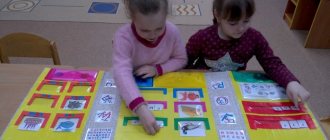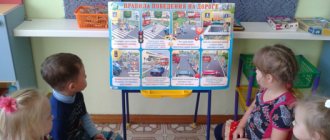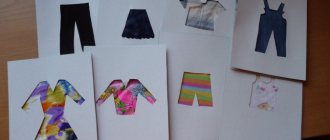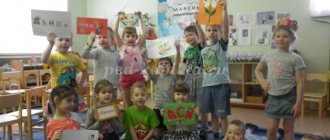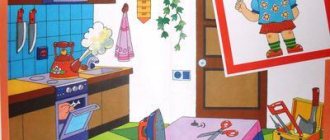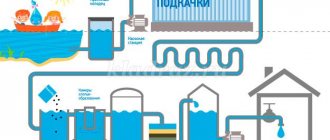Teaching older preschoolers to solve arithmetic problems
Bibliographic description:
Avsyukevich, N. I. Teaching older preschoolers to solve arithmetic problems / N. I. Avsyukevich, I. A. Bashkatova. — Text: direct // Questions of preschool pedagogy. — 2021. — No. 3 (6). — P. 103-105. — URL: https://moluch.ru/th/1/archive/41/1258/ (access date: 12/19/2021).
... Arithmetic, especially arithmetic problems, has always been recognized as having another exceptional role in learning, namely the development of intelligence and ingenuity.
A. I. Markushevich
By the time they enter school, children should have acquired a relatively wide range of interrelated knowledge about set and number, shape and size, and learn to navigate in space and time.
In the process of mathematical and general mental development of children of senior preschool age, special attention is paid to learning to solve and compose simple arithmetic problems. In kindergarten, preparatory work is carried out to develop children's confident calculation skills in adding and subtracting single-digit numbers and rapid mental calculations with two-digit numbers in order to prepare them for learning in primary school. If in school calculations are taught by solving examples and arithmetic problems, then in the practice of preschool institutions it is customary to introduce children to arithmetic operations and the simplest calculation techniques based on simple problems, the conditions of which reflect real, mainly play and everyday situations. The condition of the problem indicates the connections between the given numbers, as well as between the data and the required ones. These connections determine the choice of arithmetic operation.
Having established these connections, the child quite easily comes to understand the meaning of arithmetic operations and the meaning of the concepts “add”, “subtract”, “get”, “remain”. By solving problems, children master the ability to find relationships between quantities.
At the same time, tasks are one of the means of developing logical thinking, ingenuity, and ingenuity in children. In working with tasks, the skills of analyzing and synthesizing, generalizing and concretizing, revealing the main thing, highlighting the main thing in the text of the problem and discarding the unimportant and secondary are improved.
Simple tasks , i.e. tasks that can be solved with one action, are usually divided into the following groups:
The first group includes simple problems in which children learn the specific meaning of each arithmetic operation, i.e., which arithmetic operation corresponds to a particular operation on sets (addition or subtraction). These problems involve finding the sum of two numbers and finding the remainder.
The teacher forms ideas about the operations of addition and subtraction, and at the same time introduces children to the signs “+”, “-”, “=”. Thus, children gradually move from actions with concrete sets to actions with numbers - solving arithmetic problems and becoming familiar with notating the model of arithmetic operations using mathematical symbols.
Already in the 2nd-3rd lesson, where visual material was used, children are asked to solve oral text problems. To master the algorithm of action, exercises in independently composing tasks are useful.
4 + 2 = 6
The second group includes simple problems, when solving which it is necessary to comprehend the connection between the components and results of arithmetic operations. These are tasks to find unknown components:
a) finding the first term from the known sum and the second term.
b) finding the second term using the known sum and the first term.
c) finding the minuend from the known subtrahend and difference.
d) finding the subtrahend from the known minuend and difference.
These problems help reinforce knowledge of the structure of a problem and develop the ability to find the appropriate arithmetic operation. To help children remember numerical data better, cards with numbers, and subsequently with signs, are used.
9–3 = 6
The third group includes simple problems related to the concept of difference in ratios:
a) increasing the number by several units.
b) decreasing the number by several units.
In these problems, arithmetic operations are, as it were, prompted by the very conditions of the problem. A ratio greater than one requires the child to increase, count, add, a ratio less than one requires decrease, subtraction.
Depending on the visual material used to compose the tasks, they are divided into dramatization tasks and illustration tasks. Each type of these tasks has its own characteristics and reveals certain aspects to children, and also contributes to the development of the ability to select the necessary life, everyday, and play material for the plot of the task, and teaches them to think logically.
The peculiarity of dramatization tasks is that their content directly reflects the life of the children themselves, that is, what they just did or usually do. In dramatization tasks their meaning is most clearly revealed. Children begin to understand that the problem always reflects the specific lives of people.
The ability to think about how the content of a problem corresponds to real life contributes to a deeper knowledge of life and teaches children to consider phenomena in diverse connections, including quantitative relationships.
Problems of this type are especially valuable at the first stage of learning: children learn to compose problems about themselves, talk about each other’s actions, pose a question for solution, therefore the structure of the problem using the example of dramatization problems is most accessible to children.
A special place in the system of visual aids is occupied by tasks - illustrations. In these tasks, with the help of toys, space is created for a variety of plots. These tasks develop imagination, stimulate memory and the ability to independently come up with problems, and therefore lead to solving and composing oral problems.
Pictures are widely used to illustrate problems. The main requirements for them are simplicity of plot, dynamism of content and clearly expressed quantitative relationships between objects.
The teacher himself can create a picture task. These visual aids help to understand the meaning of an arithmetic problem and its structure.
After children have formed ideas and some concepts about an arithmetic problem, about the relationships between numerical data, between the condition and question of the problem, you can move on to familiarize yourself with the transformation of direct problems into inverse ones . This helps to better understand the specifics of each type of task. The teacher explains: any arithmetic problem can be transformed into a new one if the resulting required is considered one of the data of the new task, and one of the data of the transformed task is considered the desired one.
An example task for teaching children to solve problems in their heads.
The teacher hangs cards with tasks - pictures on which the conditions of four tasks are presented using depicted objects and arithmetic signs.
3 pears - 1 pear
2 pears+1 pear
2 berries+1 berry
3 berries - 1 berry
Choose from four picture problems the one whose solution will correspond to the given value.
1 task. The value is set to 3 pears. Which picture task is appropriate? What action should you perform in this task?
Task 2. The value is set to 2 berries. Which picture task is appropriate? What action should you perform in this task?
3 task. The teacher offers to find among the laid out picture cards those that correspond to the answer.
4 task. Try to come up with similar problems using picture cards. Children come up with the condition of the problem, tell how it should be solved, and, using cards with numbers and arithmetic signs, post the answer in an empty cell of the picture card.
An example task for introducing children to problems involving the relation “more (less) by several units.”
Problem: “Mom put 2 spoons of sugar in the car’s cup of tea, and 1 spoon more sugar in dad’s big cup. How many spoons of sugar did mom put in dad’s cup?” What is this problem about? Repeat her condition. What is asked in this problem? What needs to be done to solve the problem? There are 2 spoons of sugar in a Mashina cup - this is the first set. How many spoons of sugar are in dad's cup is unknown. This is the second set. But it is known that Dad’s cup has 1 spoon of sugar more than Masha’s cup. We need to determine the amount of sugar in the second set. There is as much sugar in dad's cup as in the first set, and one more spoon. What action will we use to solve the problem? How do we answer the problem question? Write down the solution to the problem in your notebooks using numbers and arithmetic symbols.
Familiarization with simple and inverse problems increases cognitive activity and develops the ability to think logically.
Key terms
(automatically generated)
: task, child, spoon of sugar, daddy's cup, arithmetic task, action, what action, what picture task, visual material, example task.
Living ingenuity. A collection of open developmental tasks for children and their parents with analysis of solutions
Problem 7. Who is Goldilocks?
The task:
Read a fragment of the fairy tale “Goldilocks”.
“In the middle of the hall there was a round crystal table, and behind it, on crystal chairs, sat twelve beauties, so similar to each other that Irzhik only waved his hand and lowered his eyes - how can you tell which one of them is Goldilocks! They all wear the same long dresses and the same white blankets on their heads. Not a hair is visible from underneath them.
“Well, choose,” says the king. - You guessed it - your happiness! If not, you will leave here alone, just as you came.”
We know the plot of this tale and the solution to the problem:
“Irzhik raised his eyes and suddenly heard someone buzzing right next to his ear:
- Live, go around the table. I'll give you a hint.
Irzhik looked: a small fly was flying above him. Irzhik slowly walked around the table, and the princesses sat with their eyes downcast. And everyone’s cheeks flushed equally. And the fly buzzes and buzzes:
- Not that one! Not that one! But this one, the golden-haired one!
Irzhik stopped, pretended to still have doubts, then said:
- Here is the golden-haired princess!
- Your happiness! - shouted the king. The princess quickly left the table, threw off the white coverlet, and her golden hair fell over her shoulders. And immediately the whole hall sparkled with such shine from this hair that it seemed as if the sun had given all its light to the princess’s hair.”
Let’s imagine that the magic fly doesn’t help Irzhik. Suggest other solutions to determine which princess is Goldilocks?
1. We prepare with the child to solve the problem:
• watch an excerpt from the cartoon;
• you can depict the plot of the task;
• read an excerpt from a book or the whole fairy tale.
2. We analyze the conditions of the problem with the child.
Ask your child to tell you what the task is about. The purpose of the question is to check the child’s understanding of the conditions of the task. If the condition is not fully understood, discuss it with your child in more detail.
3. Discuss with the child the pros and cons of the situation in the task.
• Why is it bad to have eleven sisters or brothers who are like you?
• What's good about having eleven sisters or brothers who are like you?
• Why is it bad that people are not alike?
• Why is it good that people are different from each other?
Get at least three answer options for each question.
4. We help the child find solutions using leading questions.
• What needs to be done to see the hair color under a hat with earflaps?
• What happens to your hair when you run fast?
• How to find out your grandmother's hair color over the phone?
• Are there any insects or animals that you are afraid of?
You can come up with other leading questions yourself based on the child’s answers and train of thought.
Possible solutions to the problem:
1. Poke a hole in the scarf.
Grade:
• practicality - 1;
• originality – 3.
If this can be done unnoticed, then the option will work. Start a series of experiments with your child, answering questions related to this idea. How could Irzhik pick the handkerchief? Try with your child to dig through thin fabric with a finger, a stick or other objects. How long did it take? How to unnoticed make a hole in a scarf when many people are looking at you, especially the king? A good opportunity to talk about magic tricks and distractions during magic tricks.
2. Ask the princesses themselves which one is Goldilocks. But they can also deceive.
Grade:
• practicality - 1;
• originality – 2.
What’s true is true; suddenly they don’t want to part with their sister. Think Irzhik, think - you will become a prince: how to ask questions so that the princesses are not deceived or their lies are obvious? At this point, the conversation with the child can be turned to discussing the signs of lying, its pros and cons, and consequences.
3. Blow hard so that the scarves fly off your heads.
Grade:
• practicality – 2;
• originality – 2.
If this can be done unnoticed, then the option will work. Is it possible to create a strong wind without being noticed? And if you shake your head too much, can the scarf come off? Do an experiment. How to make the princesses start shaking or shaking their heads themselves? A worthy inventive task.
4. Shine a strong flashlight onto a white scarf, the hair color will be visible.
Grade:
• practicality - 1;
• originality – 2.
A great excuse to experiment with a lantern, scarf and hair! It's time to discuss the history of the development of lamps. What kind of lanterns were there in ancient times? Did they shine as brightly as modern flashlights? How can you intensify the light of, for example, a kerosene lamp or candle?
5. Reflection of the head on the crystal table.
Grade:
• practicality – 2;
• originality – 2.
Indeed, there may be a gap between the scarf and the princess’s head, in which you can clearly see the color of the hair. Conduct an experiment: how a person’s face is reflected in a window glass. Discuss how a mirror is different from window glass. Find objects with your child in which you can see your reflection.
6. Hair color can be determined by eyebrows.
Grade:
• practicality - 3;
• originality – 2.
An excellent solution if the princesses did not paint their eyebrows a different color. Discuss why some women dye their eyebrows a different color. Make an observation whether people have eyebrows the same color as the hair on their head or not. Can someone other than Goldilocks have golden eyebrows? And would Goldilocks dare to dye her dazzling golden eyebrows a different color? And, most importantly, why would she do this? Let's solve this research problem.
7. Look under the princesses’ chairs to see if any hairs have fallen out.
Grade:
• practicality – 2;
• originality – 2.
Quite a plausible solution. You can also look at the backs to see if hair remains on clothes when combing. I wonder if you can ask the princesses to dance to make more hair fall? This solution can provide amazing information about how much hair a person loses per day and how many new ones appear.
8. To determine Goldilocks, I would let them have a mouse on the table. The girls would run, and the covers would fall, or at least dispel.
Grade:
• practicality – 2;
• originality – 2.
The assumption is good - most women, and men too, do not like mice. A research question arises: why can people be afraid of mice, they won’t eat a person. Discuss who else the princess might be afraid of. Here you can find out how Irzhik could guess that such a test awaited him and prudently take a “frightening” animal with him.
9. All people are necessarily different from each other. Surely Irzhik could remember some special facial features or moles when he met her in previous tests.
Grade:
• practicality – 2;
• originality – 2.
We hope that Irzhik is very attentive and quickly remembers faces. You can start a conversation with your child about how twins differ from each other, how a mother distinguishes between children, even if there are five of them. Conduct attentiveness experiments and let your child find as many differences as possible in photographs of twins found on the Internet.
10. Determine hair color by jewelry. Goldilocks must wear something red or shades of red to go with this hair color.
Grade:
• practicality – 2;
• originality – 3.
Surely the girls will make this assumption. This is an opportunity to talk about taste and aesthetics. Discuss with your child why they wear jewelry, what they are, what the purpose of jewelry was in ancient times.
